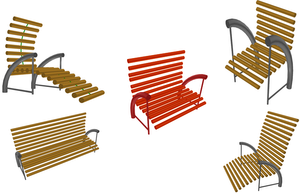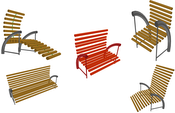Information
- Publication Type: Master Thesis
- Workgroup(s)/Project(s):
- Date: September 2014
- Date (Start): 13. January 2014
- Date (End): 2014
- First Supervisor:
- Keywords: structure-aware model manipulation, modelling, cg
Abstract
In computer graphics one of the most expensive fields is content creation. While today the rendering part is highly sophisticated and automated, 3d modeling is still a very challenging task due to the steep learning curve and the amount of work time required. Although there are a lot of free model databases available in the internet, this models are in general not perfectly suited to the customers needs and have to be adapted.Structure-aware shape manipulation deals with the complexity of creating variations, or adapting a given input model while retaining global features like symmetry and connectivity. The majority of existing algorithms only try to preserve structural features, or have very limited support for adapting the overall structure of the model to changes made by the user. The lack of complex structural changes in the model, for example allowing a wheel to change the number of strokes, limits the number of possible variations this algorithms can generate.
The aim of this thesis is to exploit the possibilities of using curves and curve spaces to find a better representation of the input model, allowing for complex structural adaptions. In addition to this the usefulness of a multi-layered graphs to represent the model and it's constraints should be investigated.
Additional Files and Images
Weblinks
No further information available.BibTeX
@mastersthesis{steiner-2014-da,
title = "Structure-aware shape manipulation",
author = "Bernhard Steiner",
year = "2014",
abstract = "In computer graphics one of the most expensive fields is
content creation. While today the rendering part is highly
sophisticated and automated, 3d modeling is still a very
challenging task due to the steep learning curve and the
amount of work time required. Although there are a lot of
free model databases available in the internet, this models
are in general not perfectly suited to the customers needs
and have to be adapted. Structure-aware shape manipulation
deals with the complexity of creating variations, or
adapting a given input model while retaining global features
like symmetry and connectivity. The majority of existing
algorithms only try to preserve structural features, or
have very limited support for adapting the overall structure
of the model to changes made by the user. The lack of
complex structural changes in the model, for example
allowing a wheel to change the number of strokes, limits the
number of possible variations this algorithms can generate.
The aim of this thesis is to exploit the possibilities of
using curves and curve spaces to find a better
representation of the input model, allowing for complex
structural adaptions. In addition to this the usefulness of
a multi-layered graphs to represent the model and it's
constraints should be investigated. ",
month = sep,
address = "Favoritenstrasse 9-11/E193-02, A-1040 Vienna, Austria",
school = "Institute of Computer Graphics and Algorithms, Vienna
University of Technology ",
keywords = " structure-aware model manipulation, modelling, cg",
URL = "https://www.cg.tuwien.ac.at/research/publications/2014/steiner-2014-da/",
}

 poster
poster thesis
thesis


